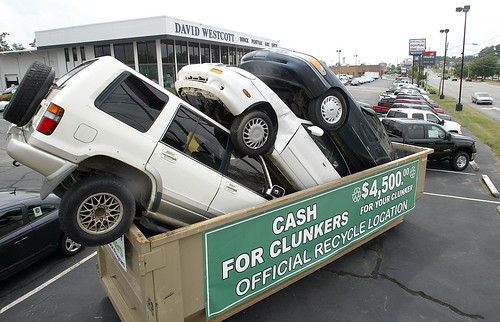Thanks to Cash for Clunkers, Hybrid Sales Rises 31.8% in July; New Vehicle Sales Up 3.55%
(Source: Green Car Congress)
This post is sponsored by LemonFree.com
Buoyed by the US government’s CARS (“Cash for Clunkers”) program, US auto sales slowed their decline in the US in July, dropping on 12.1% to 997,824 units, accordingto summary figures from AutoData. Passenger car sales dropped 10.6% to 554, 527 units, while light truck sales dropped 14.1% to 443, 297 units. All comparisons are by volume. As a result, the SAAR for July surged to 11.24 million units; US SAAR had been below 10 million since January.
Hybrids had an especially good month, with reported sales jumping 31.8% year-on-year to 35,429 units, representing a 3.55% new vehicle sales market share for the month—the highest monthly share yet. Hybrid gains were largely due to an increase in Prius sales (up 29.7% to 19,173 units) and Ford hybrids (up 323% to 5,353 units).
According to the Alliance of Automobile Manufacturers, CARS sales reflected demand for more fuel-efficient vehicles:
- Ford reported a 9 mpg increase from trade-in vehicle to new vehicle purchase;
- GM reported a 54% increase in small car sales since the CARS program was launched;
- 57% of Mazdas sold so far under the program were fuel-efficient Mazda 3’s;
- 78% of Toyota’s CARS sales volume consists of Corolla, Prius, Camry, RAV 4 and Tacoma, which average a combined 30 mpg;
- Volkswagen reports more than 60% of its CARS sales are clean diesel Jetta TDIs which get an EPA combined 34 mpg.
Here is a quick snapshot of sales volume by manufacturer (in the hybrid category):
- GM delivered a total of 1,487 hybrid vehicles were delivered in the month, up 36.3% year-on-year.
- Ford’s fuel-efficient vehicles pace July sales results. Ford had an exceptionally strong month with hybrid sales, up 323% year-on-year to 5,353 units.
- Toyota Motor Sales (TMS) posted July sales of 24,295 hybrid vehicles, up 19.3% from the same period last year.
- Total sales of the fuel-efficient Honda Civic increased 3.1% to 30,037. Sales of the Civic Hybrid, however, plunged 71.8% to 969 units year-on-year. The new Honda Insight hybrid posted 2,295 units.
- Nissan sold 1,030 units of the Altima hybrid, up 44.1% year-on year.
Our friends at Jalopnik yesterday published a revised list of ten most purchased vehicles under the Cash for Clunkers program:
1. Ford Focus
3. Honda Civic
4. Toyota Prius
5. Toyota Camry
9. Honda Fit
10. Chevrolet Cobalt
Click here to read the entire report.
Toyota Prius Tops May Auto Sales in Japan; Hybrid Sales Soar in Japan, Despite Downturn
This post is sponsored by LemonFree.com
(Source: Wall Street Journal, Green Car Congress & Tree Hugger)
Last month (May 2009), the Toyota Prius was the top selling model in the world’s second-largest economy; the rival Honda Insight hybrid came in third, according to new car sales rankings—excluding minicars with displacements of less than 660 cc—released by the Japan Automobile Dealers Association (JADA).
In April Honda was quite happy to report that its new Insight hybrid was both the best selling car in Japan for that month (outselling the Toyota Prius) and the first hybrid car to have that honor with 10,481 units. (Earlier post.) In May, the Insight dropped to third place with 8,183 units, behind the Prius and the Honda Fit, with 8,859 units.Toyota’s May performance was all the more surprising, since the third-generation Prius didn’t go on sale until May 18.
was quite happy to report that its new Insight hybrid was both the best selling car in Japan for that month (outselling the Toyota Prius) and the first hybrid car to have that honor with 10,481 units. (Earlier post.) In May, the Insight dropped to third place with 8,183 units, behind the Prius and the Honda Fit, with 8,859 units.Toyota’s May performance was all the more surprising, since the third-generation Prius didn’t go on sale until May 18.
The Prius posted 10,915 units in May, in Japan more than twice the 5,079 units sold in May 2008 and compared to 1,952 units in April 2009, according to the JADA data. (In the US, Toyota reported 10,091 units of the Prius sold in May.)
There are several possible explanations—beyond the fact that both Toyota and Honda have cut prices to make hybrids a little less niche and a little more mass market. First, generous government incentives: Japan’s stimulus package included a range of tax breaks for buyers of hybrid (and electric) vehicles which can knock thousands of dollars off the price tag. Japan has tougher mileage standards—but that affects what kind of cars manufacturers turn out, not what kind of cars consumers flock to. One huge difference is the price of gasoline—which automatically makes the hybrids more attractive, especially in a recession. Japan, like many European countries, slaps a hefty national tax on gas. Right now, Japanese pump prices work out to $4.61 a gallon. That compares to a U.S. national average of about $2.50 a gallon.
Over 1.8 Million new and used cars

